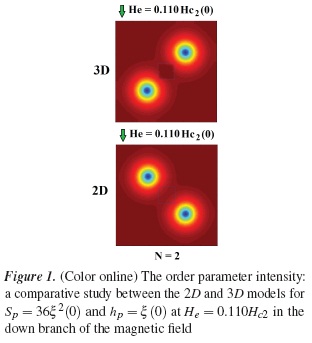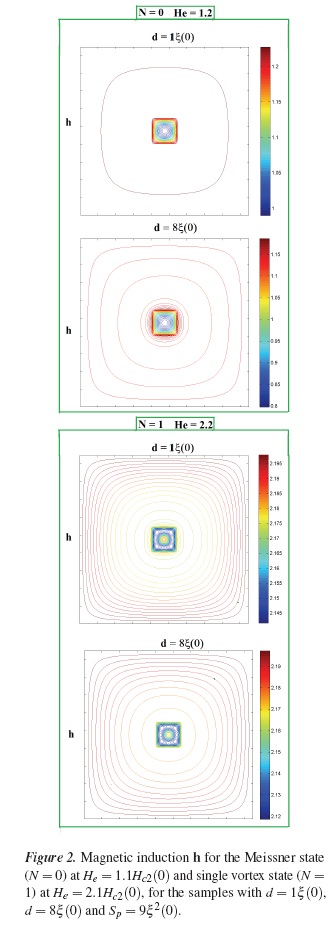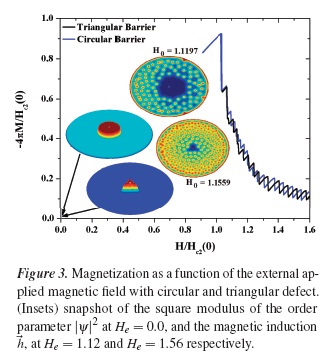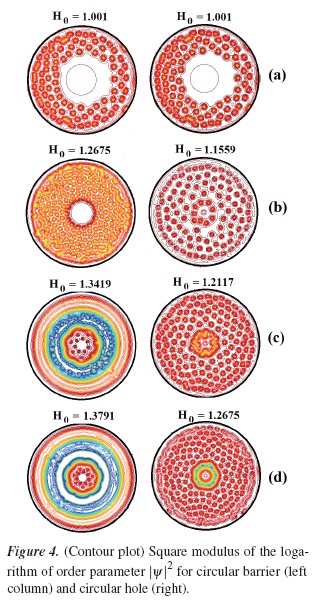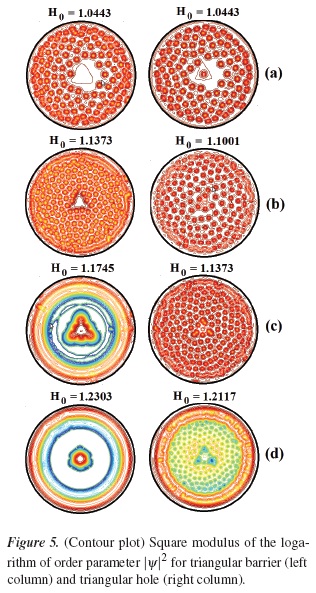Services on Demand
Journal
Article
Indicators
-
 Cited by SciELO
Cited by SciELO -
 Access statistics
Access statistics
Related links
-
 Cited by Google
Cited by Google -
 Similars in
SciELO
Similars in
SciELO -
 Similars in Google
Similars in Google
Share
Ciencia en Desarrollo
Print version ISSN 0121-7488
Ciencia en Desarrollo vol.5 no.2 Tunja July/Dec. 2014
Controlled Manipulation of Vortices in 3D/2D Superconducting Samples
Manipulación controlada de vórtices en muestras superconductoras 2D/3D
J. González-Acostaa,*
J. Aguilar-Siadoa
J. Barba-Ortegab
a Grupo de Física en Teoría de la Materia Condensada, Universidad del Magdalena, Santa Marta, Colombia.
* Autor de correspondencia: jedgonzalezac@unal.edu.co
b Departamento de Física, Universidad Nacional de Colombia, Bogotá, Colombia.
Recepción: 07-oct-14 Aceptación: 09-nov-14
Abstract
It is well-known that the time dependent Ginzburg-Landau theory is a reliable theoretical tool to investigate the Shubnikov state in a superconductor sample in presence of an external applied magnetic field. In this work, we solved the system of the Ginzburg-Landau equations in two and three dimensions for two particular cases: For a parallelepiped with volume Vp; with transversal area Sp = 9ξ 2(0), 36ξ 2(0) and height hp = 1ξ (0),6ξ (0), where ξ (0) is the coherence length. In the other hand, for a thin disk with a centered circular and triangular defect, with topology of dot/anti-dot. In both cases are immersed into a homogeneous magnetic field. The effects of pinning/anti-pinning forces due to defects in the disk and demagnetization effects due to the finite size of the parallelepiped on configuring vortices and critical fields are discussed. In the tridimensional case, the magnetic field and the order parameter are not invariant along the direction z.
Key words: Ginzburg-Landau, Mesoscopic System, Vortices.
Resumen
Es bien conocido que la teoría de Ginzburg-Landau es una herramienta teórica confiable para investigar el estado de Shubnikov en muestras superconductoras en presencia de campos magnéticos aplicados. En este trabajo resolvemos el sistema de ecuaciones Ginzburg Landau en dos y tres dimensiones en dos casos particulares: para un paralelepípedo de volumen Vp; con área transversal Sp = 9ξ 2(0), 36ξ 2(0) y altura hp = 1ξ (0),6ξ (0), donde ξ (0) es la longitud de coherencia y por otra parte, para un disco fino con un defecto circular y triangular centrado con topología punto/anti-punto. En ambos casos las muestran estan submersas en un campo magnético homogeneo. Los efectos de las fuerzas de anclaje/anti-anclaje debido a los defectos en el disco y los efectos de demagnetización debido al tamaño finito del paralelepipedo sobre la configuración de vortices y campos críticos son discutidos. En el caso tridimensional, el campo magnético y el parámetro de orden no son invariantes a lo largo de la dirección z.
Palabras clave: Ginzburg-Landau, Vortices, Sistemas Mesoscopicos.
1. Introduction
If the size of the superconducting sample along the direction of the external magnetic field is applied is smaller than the lateral dimensions of its cross section, the demagnetizing effects (the shielding currents produced an stray field which enhance the magnetic induction near the edge of the sample) plays a very important role in the superconducting physics. Then, the magnetic field necessary to nucleate vortices in mesoscopics samples, is larger than the equivalent for macroscopic samples, which is just the applied field [1, 2]. In 2013, F. Rogeri et. al studied the magnetic field profile in a superconducting with SQUID geometry employing a genuinely 3D approach for the Ginzburg Landau equations [3]. Several authors studied the magnetic properties in mesoscopic three-dimensional disk and spheres, they found different features in the magnetization measured by comparatively small Hall probes and the creation of a surface layer at higher magnetic fields that increase the number of vortices in the sample [4, 5]. In a recent work, using the conventional 2D Ginzburg-Landau approximation, the authors of this paper studied the influence of a pentagonal/hexagonal trench/barrier on the superconducting state of a mesoscopic disk, they found new phenomena due to the competing interactions of the boundary/geometry/ and nanoengineered defects [6, 7]. The possibility to control the vortex density has made them one of the favorite experimental [8]−[13] and theoretical [14]−[16] systems for studies of the physics of solid state. Due to the experimental advances is possible to propose almost any mesoscopic system for theoretical study and obtain their critical parameters, which determine the properties of the superconductor and its applications. This is of interest for fundamental physics, also for potential device applications in nanoelectronics [19]−[21]. In this paper, We show that different of vortex lattice structures can be obtained, some of which have symmetries that depend on from the geometric of the defect and the interaction between the surface and strong pinning/anti-pinning centers.
2. Theory
We simulate a superconducting parallelepiped of variable volume Vp = Sphpξ 3(0), hp and Sp takes values 1ξ (0),6ξ (0),8ξ (0), and 9ξ 2(0), 36ξ 2(0) respectively, with a temperature T = 0 and κ = 1.0. The applied magnetic field He was ramped in steps of ΔH = 10−3. The superconducting state is described in the Ginzburg-Landau theory by the order parameter |ψ|, where |ψ|2 represent the superconducting electronic density, and the potential vector A, related to magnetic induction by B = ∇ × A [22, 23]:
For the parallelepiped case we solve the real 3D Ginzburg-Landau equations, the size of the simulation box is taken large to ensure that the local magnetic field equals the applied field far from the sample boundaries:
where ∂ Ωsc is the superconducting material-vacuum interface and ∂ Ω is the vacuum-vacuum interface, and n is the outward unit vector, normal to the interface ∂ Ωsc [3]. For the thin disk with defects we solve the 2D Ginzburg-Landau equations [26, 27]:
where g(r, θ ) is a function which describes the thickness of the sample. In this case, the magnetic field can be taken nearly uniform inside the superconductor H0 = ∇ × A0 [27]. For a 2D superconducting square sample we take g(x, y)= 1.0 in all computational mesh.
3. Results and Discussion
3.1. 3D Case
The Figure 1 show the order parameter intensity in a comparative study between the 2D and 3D models for Sp = 36ξ 2(0) and hp = ξ (0) at He = 0.110Hc2 in the down branch of the magnetic field. As we can see this case present a topological difference in the vortex configuration.
In the Figure 2 we shown the magnetic induction h for the Meissner state (N = 0) at He = 1.2Hc2(0) and single vortex state (N = 1) at He = 2.2Hc2(0), for the samples with d = 1ξ (0), d = 8ξ (0) and Sp = 9ξ 2(0) at the middle plane of the superconductor (z = 0). As we can see, the demagnetization effects are more significant in the Meissner state.
3.2. 2D Case
For the thin disk, the parameters used in our numerical simulations were: κ = 0.8854, T = 0. The disk radii is R = 26ξ (0). Figure 3 we can see that the magnetization curves for the superconducting disk with triangular or circular defect are qualitatively similar, and the density of the superconducting electrons show appreciable modifications in its configuration. The values of the critical magnetic fields for the first and second vortices entrance Hfirst = 1.033Hc2, Hsecond = 1.067Hc2 are approximately the same for circular (blue line) and triangular (black line) defects. In the Figure 4 we shown the contour plot of the order parameter for several vorticities. The disk with central defect barrier is in the left column and with a hole defect is in the right column. The vortices nucleate at the central region of the surface (a), in spite of differences between H0 values in line (b), the pinning state is obtained first using a hole defect, posteriorly, in line (c), for indicated values of H0 the force of vortex-vortex interaction overcomes the repulsive force exerted by the barrier and several vortex are found in this defect. Finally, line (d) shown the hole defect reaching normal state, whereas for larger values of H0 vortices can be discriminated. In the following, we analyze a superconducting disk with triangular defects Figure 5 which exhibit different behaviour of pinning effect. line (a) shown a typical vortices entrance in both case triangular barrier (left column) and hole (right column), but in line (b), that the vortices are found in the hole defect with H0 = 1.1c2, whereas there is no penetration of vortices, as we can see, in the defect barrier with H0= 1.174Hc2, similar situation occurs in line (c). By increasing the applied magnetic field the number of vortices is increased in the triangular hole defect and it become to normal state, however, the magnetic flux penetrate in the triangular barrier from the boundary until reach the normal state without vortex nucleation.
4. Conclusion
In conclusion, the analysis of a 3D superconductor show that the demagnetization effects are more significant in the Meissner state. For the 2D case, our calculations show that novel vortex structures can be obtained as well as its symmetries can be modified choosing the correct defect in presence of an external magnetic field applied perpendicular at its surface.
Acknowledgements
The authors would like to thank Edson Sardella for their very useful discussions. This work was partially financed by the Universidad del Magdalena (Fonciencias) and the Colombian Agency Colciencias through doctoral scholarships 567.
References
[1] E. H. Brandt and G. P. Mikitik, "Vortex Shaking in Superconducting Platelets in an Inclined Magnetic Field", Superconducting Scicience and Technology, vol. 20, pp. 111, 2007. [ Links ]
[2] E. H. Brandt," Anisotropic Superconducting Strip in an Oblique Magnetic Field", Physical Review B, vol. 72, pp. 024529, 2005. [ Links ]
[3] F. Rogeri, R. Zadorosny, P. N. Lisboa-Filho, E. Sardella, and W. A. Ortiz, "Magnetic field profile of a mesoscopic SQUID-shaped superconducting film", Superconducting Scicience and Technology, vol.26, p.p 075005, 2013. [ Links ]
[4] M. M. Doria, Antonio R. de C. Romaguera, and F. M. Peeters, "Vortex patterns in a mesoscopic superconducting rod with a magnetic dot" Physical Review B, vol. 75, pp. 064505, 2007. [ Links ]
[5] B. Xu, M. V. Milosevic, and F. M. Peeters, "Magnetic properties of vortex states in spherical superconductors", Physical Review B, vol. 77, p.p 144509, 2008. [ Links ]
[6] J. Barba-Ortega, J. D. González and Edson Sardella, "Superconducting State of a Disk with a Pentagonal/Hexagonal Trench/Barrier", Journal of Low Temperature Physic, vol.174, pp. 96, 2014. [ Links ]
[7] J. Barba-Ortega, J. Barón Jaimez and J. Albino Aguiar, "Superconducting state of a perforated mesoscopic disk with a square or triangular trench", Modern Physics Letters B, vol. 27, no. 15, pp. 1350115, 2013. [ Links ]
[8] A. E. Koshelev, V. M. Vinokur, "Suppression of surface barrier in superconductors by columnar defects", Physical Review B, vol. 64, pp. 134518, 2001. [ Links ]
[9] D. S. Golubovic, M. V. Milosevic, F. M. Peeters, V. V. Moshchalkov, "Magnetically induced splitting of a giant vortex state in a mesoscopic superconducting disk", Physical Review B, vol. 71, pp. 180502, 2005. [ Links ]
[10] M. V. Milosevic, F. M. Peeters, "Vortex-Antivortex Lattices in Superconducting Films with Magnetic Pinning Arrays", Physical Review Letters, vol. 93, pp 267006, 2004. [ Links ]
[11] M. V. Milosevic, F. M. Peeters, "Superconducting Wigner vortex molecule near a magnetic disk", Physical Review B, vol. 68, pp. 024509, 2003. [ Links ]
[12] G. R. Berdiyorov, B. J. Baelus, M. V. Milosevic, F. M. Peeters, "Stability and transition between vortex configurations in square mesos copic samples with antidots", Physical Review B, vol. 68, pp. 174521, 2003. [ Links ]
[13] M. V. Milosevic, G. R. Berdiyorov, F. M. Peeters, "Fluxonic cellular autómata", Applied Physics Letters, vol. 91, pp. 212501, 2007. [ Links ]
[14] J. Barba-Ortega, E. Sardella, J. Albino Aguiar, F. M. Peeters, "Non-conventional vortex configurations in a mesoscopic flat disk", Physica C, vol. 487, pp. 47, 2013. [ Links ]
[15] J. Barba-Ortega, E. Sardella, J. Albino Aguiar, "Nucleation of Superconductivity in a Thin Disk with a Ring-Like Defect", Modern Physics Letters B, vol. 27, no. 4, pp. 1350025, 2013. [ Links ]
[16] K. Harada, O. Kamimura, H. Kasai, T. Matsuda, A. Tonomura, and V. V. Moshchalkov, "Direct Observation of Vortex Dynamics in Superconducting Films with Regular Arrays of Defects", Science, vol. 274, pp. 1167, 1996. [ Links ]
[17] V. V. Moshchalkov, M. Baert, V. V. Metlushko, E. Rosseel, M. J. Van Bael, K. Temst, R. Jonckheere, Y. Bruynseraede, "Magnetization of multiple-quanta vortex lattices", Physical Review B, vol. 54, pp. 7385, 1996. [ Links ]
[18] G. R. Berdiyorov, M. V. Miloevi, F. M. Peeters, "Novel Commensurability Effects in Superconducting Films with Antidot Arrays", Physical Review Letters, vol. 96, pp. 207001, 2006. [ Links ]
[19] S. Raedts, A. V. Silhanek, M. J. Van Bael, V.V. Moshchalkov, "Flux-pinning properties of superconducting films with arrays of blind holes", Physical Review B, vol. 70, pp. 024509, 2004. [ Links ]
[20] M. Lange, M. J. Van Bael, Y. Bruynseraede, and V. V. Moshchalkov, "Nanoengineered Magnetic-Field-Induced Superconductivity", Physical Review Letters, vol. 90, pp. 197006, 2003. [ Links ]
[21] E. Zeldov, A. I. Larkin, V. B. Geshkenbein, M. Konczykowski, D. Majer, B. Khaykovich, V. M. Vinokur, and H. Shtrikman, "Geometrical Barriers in High-Temperature Superconductors", Physical Review Letters, vol. 73, pp. 1428, 1994. [ Links ]
[22] S. J. Chapman, Q. Du, and M. S. Gunzburger, "A model for variable thickness superconducting thin films", Zeitschrift für angewandte Mathematik und Physik, vol. 47, pp 410, 1996. [ Links ]
[23] W. D. Gropp, H. G. Kaper, G. K. Leaf, D.M. Levine, M. Palumbo, and V. M. Vinokur, "Numerical simulation of vortex dynamics in type-II superconductor", Journal Computational Physics, vol. 123, pp. 254, 1996. [ Links ]
[24] Q. Du, M. D. Gunzburger, "A model for superconducting thin film having a variable thickness", Physica D, vol. 69, pp. 215, 1993. [ Links ]
[25] R. G. Mints, I. B. Shapiro, "Surface-barrier and magnetization relaxation in layered superconductors", Physical Review B, vol. 47, pp. 3273, 1993. [ Links ]
[26] G. R. Berdiyorov, M. V. Milosevic, B. J. Baelus, F. M. Peeters, "Superconducting vortex state in a mesoscopic disk containing a blind hole", Physical Review B, vol. 70, pp. 024508, 2004. [ Links ]
[27] E. Sardella, P. N. L. Filho, A. L. Malvezzi, "Vortices in a mesoscopic superconducting circular sector", Physical Review B, vol. 77, pp 104508, 2008. [ Links ]


















